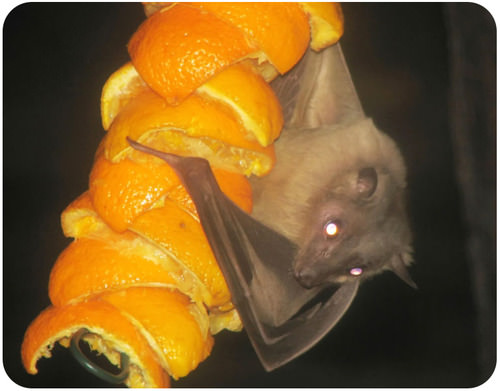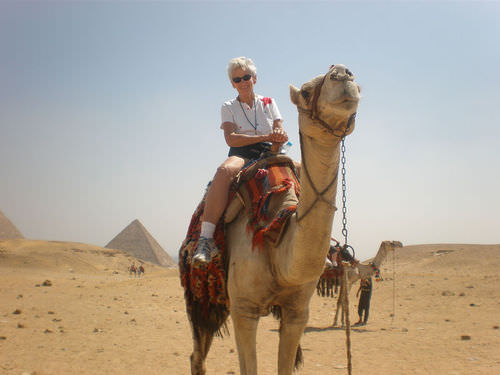10.23: Importance of Mammals
- Page ID
- 14176

How are mammals helpful?
An example of a helpful mammal is a service dog. Like many dogs, service dogs can pick up or retrieve objects for their owners. They can also perform many other tasks for a disabled person, depending on the type of disability.
Importance of Mammals
Mammals play many important roles in ecosystems, and they also benefit people.
Importance to Ecosystems
Mammals have important roles in the food webs of practically every ecosystem. Mammals are important members of food chains and food webs, as grazers and predators. Mammals can feed at various levels of food chains, as herbivores, insectivores, carnivores and omnivores.
Mammals also interact with other species in many symbiotic relationships. For example, bats have established mutually beneficial relationships with plants. Nectar-feeding bats receive a tasty treat from each flower, and, in return, they pollinate the flowers. That means they transfer pollen from one flower to another, allowing the plant to reproduce. Non-flying mammalian pollinators include marsupials, primates, and rodents. In most cases, these animals visit flowers to eat their nectar, and end up with pollen stuck to their bodies. When the animal visits another flower to eat the nectar, the pollen is transferred to that flower.
Fruit-eating bats (Figure below) also receive food from plants. In return, they help these plants spread their seeds. When bats consume fruit, they also consume the seeds within the fruit. Then they carry the seeds in their guts to far-away locations.
Zebras have been known to befriend ostriches. In this symbiotic relationship, both species benefit. The ostrich, with its terrible senses of smell and hearing and the zebra with its poor eyesight, are both able to warn the other when danger is near. The zebra can smell or hear certain dangers approaching, while the ostrich can see other dangers. Both are prepared to warn one another at a moment’s notice so they can each flee when necessary.
Baboons and impala have a similar relationship. Impala are one of the most common prey species for all predators and need to be constantly alert. Impala have good hearing and eyesight, raising an alarm when danger is near. Baboons use trees to check for danger and bark an alarm when danger is sensed. What do the baboons receive? Male baboons sometimes prey on young impala soon after birth. So, though both alert others to dangers, sometimes this is not the best of relationships for young impala.
Zebra and wildebeest are found together on the African savanna grazing different parts of the same grass. The zebra grazes the tougher parts of the plant, saving the softer parts for the wildebeest. A zebra will move into an area of tall grass before other herbivores and graze the grass down to the area that the wildebeest prefers.

Importance to Humans
We see examples of mammals (other than people!) serving our needs everywhere. We have pets that are mammals, such as dogs and cats. Mammals are also used around the world for transport. For example, horses, donkeys, mules, or camels (Figure below) may be the primary means of transport in some parts of the world. Mammals also do work for us. Service dogs can be trained to help the disabled. These include guide dogs, which are assistance dogs trained to lead blind and visually impaired people around obstacles. Horses and elephants can carry heavy loads. Humans also use some mammals for food. For example, cows and goats are commonly raised for their milk and meat. Mammals’ more highly developed brains have made them ideal for use by scientists in studying such things as learning, as seen in maze studies of mice and rats.

Cultural Importance
Mammals have also played a significant role in different cultures’ folklore and religion. For example, the grace and power of the cougar have been admired in the cultures of the native peoples of the Americas. The Inca city of Cuzco is designed in the shape of a cougar, and the thunder god of the Inca, Viracocha, has been associated with the animal. In North America, mythological descriptions of the cougar have appeared in the stories of several American Indian tribes.
Important mammals include Dolly the sheep, Lassie the dog, and flipper the dolphin. Dolly was the first mammal to be cloned from an adult somatic (body) cell, using the process of nuclear transfer. Lassie was a collie dog who appeared in seven full length feature films in the 1940s and 1950s, starting with Lassie Come Home in 1943. Additional Lassie movies were made as recently as 2005. Between 1954 and 1973, the Lassie television series aired, with plenty of additional productions as recently as 2007. Flipper was a bottle nose dolphin that starred in a television series between 1964 and 1967. The most famous mammal may be King Kong, the giant gorilla that terrorized New York City in 1933 in the movie of the same name.
Summary
- Ecologically, nectar-feeding and fruit-eating bats play an important role in plant pollination and seed dispersal, respectively.
- Mammals meet people's needs by serving as pets, transport, food, or research subjects.
Explore More
Use the resources below to answer the questions that follow.
Explore More I
- Arctic: Greenland Sled Dogs at http://www.youtube.com/watch?v=QeDv3hVcc8A (3:02)
- How many sled dogs are there living above the Arctic Circle in Greenland?
- How far can a sled dog team travel in a day?
- What advantages do sled dogs have over snowmobiles?
- What are some ways in which the Inuit depend on sled dogs?
Review
- How do mammals impact ecosystems? Describe two ways.
- Describe one symbiotic relationship between mammals.
- How do mammals help people? Describe two ways.
- Which mammals is your favorite? Why?

